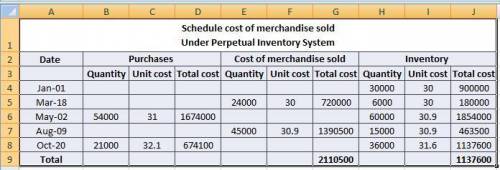
Weighted Average Cost Flow Method Under Perpetual Inventory System
The following units of a particular item were available for sale during the calendar year:
Jan. 1 Inventory 30,000 units at $30.00
Mar. 18 Sale 24,000 units
May 2 Purchase 54,000 units at $31.00
Aug. 9 Sale 45,000 units
Oct. 20 Purchase 21,000 units at $32.10
The firm uses the weighted average cost method with a perpetual inventory system. Determine the cost of merchandise sold for each sale and the inventory balance after each sale. Present the data in the form illustrated in Exhibit 5. Round unit cost to two decimal places, if necessary.
Schedule of Cost of Merchandise Sold
Weighted Average Cost Flow Method
Purchases Cost of Merchandise Sold Inventory
Date Quantity Unit Cost Total Cost Quantity Unit Cost Total Cost Quantity Unit Cost Total Cost
Jan. 1 $ $
Mar. 18 $ $
May 2 $ $
Aug. 9
Oct. 20
Dec. 31 Balances $ $ $

Answers: 3


Another question on Business

Business, 22.06.2019 04:10
You are head of the schwartz family endowment for the arts. you have decided to fund an arts school in the san francisco bay area in perpetuity. every 5 years, you will give the school $ 1 comma 000 comma 000. the first payment will occur 5 years from today. if the interest rate is 5.9 % per year, what is the present value of your gift?
Answers: 1

Business, 22.06.2019 08:30
Most angel investors expect a return on investment of question options: 20% to 25% over 5 years. 15% to 20% over 5 years. 75% over 10 years. 100% over 5 years.
Answers: 1

Business, 22.06.2019 19:40
Last year ann arbor corp had $155,000 of assets, $305,000 of sales, $20,000 of net income, and a debt-to-total-assets ratio of 37.5%. the new cfo believes a new computer program will enable it to reduce costs and thus raise net income to $33,000. assets, sales, and the debt ratio would not be affected. by how much would the cost reduction improve the roe? a. 11.51%b. 12.11%c. 12.75%d. 13.42%e. 14.09%
Answers: 3

Business, 22.06.2019 20:40
Answer the questions about keynesian theory, market economics, and government policy. keynes believed that there were "sticky" wages and that recessions are caused by increases in prices. decreases in supply. decreases in aggregate demand (ad). increases in unemployment. keynes believed the government should increase ad through increased government spending, but not tax cuts. control wages to increase employment because of sticky wages. increase employment through tax cuts only. increase as through tax cuts. increase ad through either increased government spending or tax cuts. intervene when individual markets fail by controlling prices and production.
Answers: 2
You know the right answer?
Weighted Average Cost Flow Method Under Perpetual Inventory System
The following units of a particu...
Questions




Biology, 31.01.2020 22:45

Mathematics, 31.01.2020 22:45


Mathematics, 31.01.2020 22:46


Mathematics, 31.01.2020 22:46




History, 31.01.2020 22:46


Mathematics, 31.01.2020 22:46

English, 31.01.2020 22:46

Mathematics, 31.01.2020 22:46


Biology, 31.01.2020 22:46






